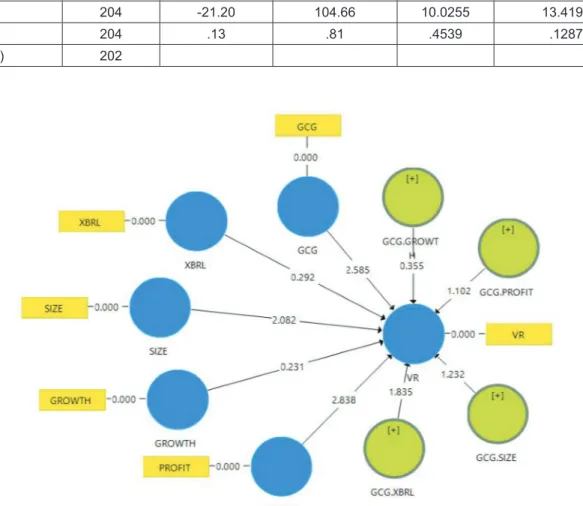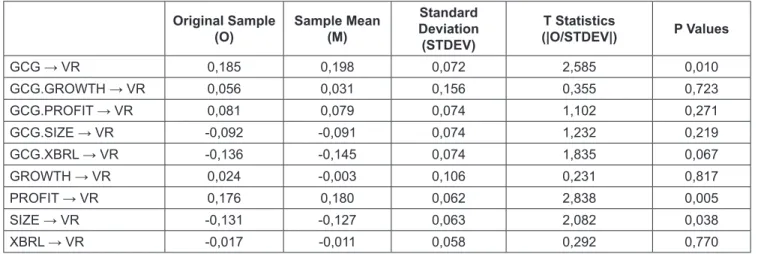Print ISSN: 2288-4637 / Online ISSN 2288-4645 doi:10.13106/jafeb.2020.vol7.no11.335
Corporate Governance and Value Relevance in Indonesia Manufacturing Companies
Yunika MURDAYANTI
1, I Gusti Ketut Agung ULUPUI
2, Indra PAHALA
3, Susi INDRIANI
4, S. SUHERMAN
5Received: August 01, 2020 Revised: September 20, 2020 Accepted: October 05, 2020
Abstract
This study aims to describe the role of corporate governance as a moderator in electronic financial disclosure that adopts Extensible Business Reporting Language (XBRL) and Company Characteristics on value relevance. The population in this study was all manufacturing companies listed on the Indonesia Stock Exchange from 2017 to 2018, totaling 166 companies. The sampling technique used purposive sampling method, namely, manufacturing companies that publish fully audited financial statements by December 31 of the year 2017-2018. The method used in this research is a quantitative description using the financial statements of manufacturing companies listed on the Indonesia Stock Exchange that have adopted XBRL during the 2017-2018 period. The data analysis method used is multiple regression analysis with moderating variables. The results of this study show a negative and insignificant effect of XBRL on value relevance, a significant negative effect of size on value relevance, a positive and insignificant effect of growth on value relevance, and a significant positive effect of profit on value relevance; meanwhile, corporate governance moderation variable has an insignificant effect in all hypotheses. Suggestions are to increase the number of variables that have an important role in value relevance and expand the number of research objects to be compared.
Keywords: XBRL, Company Characteristics, Value Relevance, Corporate Governance JEL Classification Code: M40, M41, M48
by humans. Indonesia is considered to be an ASEAN country that has high optimism in terms of readiness to implement Industry 4.0. Artificial intelligence does not only reduce errors in activities that were previously handled by humans, but for companies, it is the achievement of effectiveness and efficiency in their operations (Cahyadi, 2019).
Along with the development of Internet in the era of the Industrial Revolution 4.0, as it is today, the practice of corporate financial reporting through the World Wide Web is increasingly common and has become one of the main sources of information related to companies. Reporting via the Internet offers many benefits for companies and users of financial reports, one of which is the ease of disseminating and accessing financial information, and increasing the timeliness of reporting (Mahardika, 2018). It is hoped that information that is owned by a company or a country can be used and processed quickly and efficiently if the information is presented in the same language format. Therefore, to realize this desire and also be able to support the creation of facilities in the implementation of business intelligence, and make it easier for investors and regulators to access and process the data needed for decision-making, an integrated solution is needed in standardizing the language of reporting information, in this case, Extensible Business Reporting Language (XBRL).
1. Introduction
The development of IT or digitalization is the result of the technological revolution, especially information, which has changed almost all aspects of life, including the running of in the business world. The Industrial Revolution 4.0 is marked by significant technological advance, which is the emergence of artificial intelligence technology has changed many things in life, including eliminating many activities that were previously done
1
First Author and Corresponding Author. Lecturer, Faculty of Economics, Universitas Negeri Jakarta, Indonesia [Postal Address:
Pesona Khayangan V Blok N No.7 Jl Ir Juanda Depok, West Java, 16411, Indonesia] Email: yunika_murdayanti@unj.ac.id
2
Lecturer, Faculty of Economics, Universitas Negeri Jakarta, Indonesia. Email: Igka-Ulupui@unj.ac.id
3
Lecturer, Faculty of Economics, Universitas Negeri Jakarta, Indonesia. Email: indrapahala@unj.ac.id
4
Lecturer, Faculty of Economics, Universitas Negeri Jakarta, Indonesia. Email: sisusie.indriani@unj.ac.id
5
Lecturer, Faculty of Economics, Universitas Negeri Jakarta, Indonesia. Email: suherman@unj.ac.id
© Copyright: The Author(s)
This is an Open Access article distributed under the terms of the Creative Commons Attribution Non-Commercial License (https://creativecommons.org/licenses/by-nc/4.0/) which permits unrestricted non-commercial use, distribution, and reproduction in any medium, provided the original work is properly cited.


